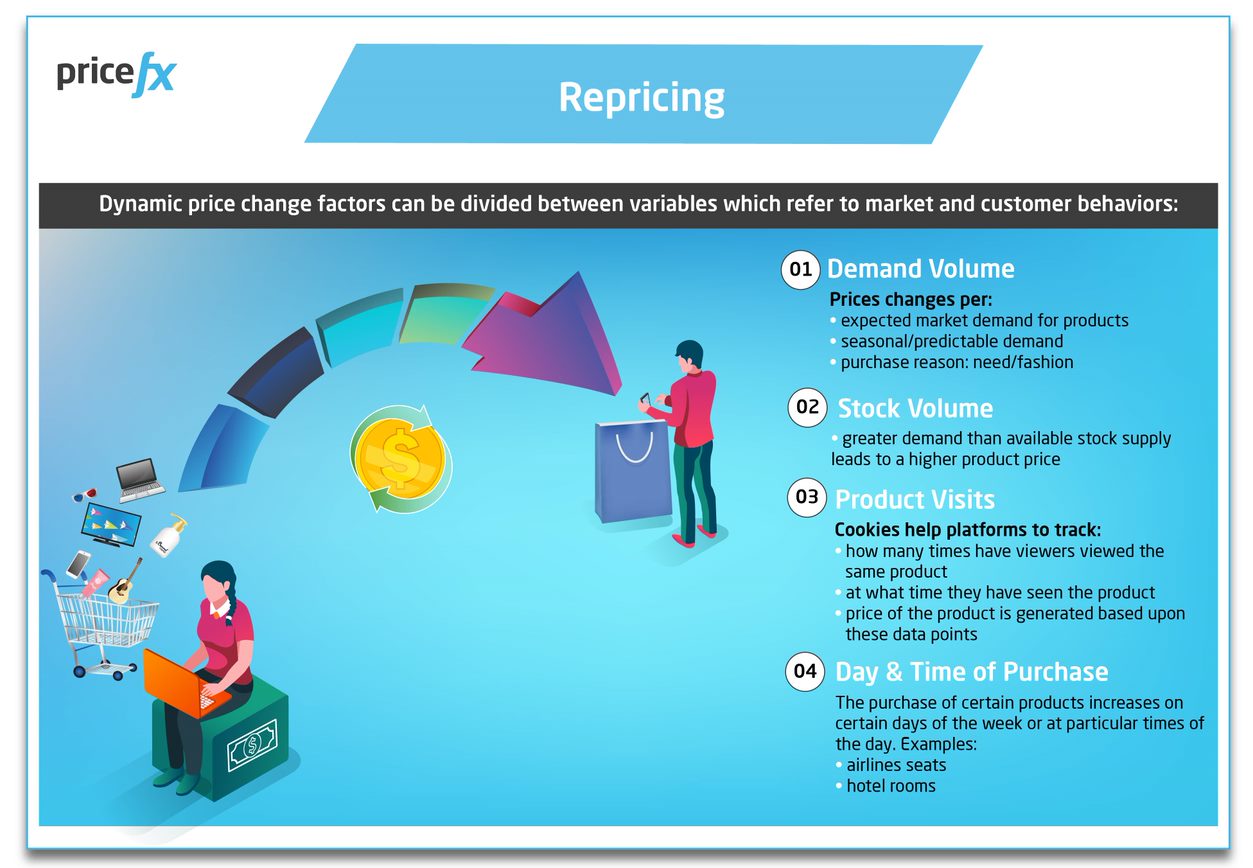Dynamic Pricing: What it is & How it Can Help Your Business
December 27th, 2023 | 11 min. read
Dynamic pricing is a pricing strategy that has been gaining popularity in recent years, particularly in the retail industry. It involves adjusting the prices of products or services in real-time, often based on supply and demand or other relevant factors. This pricing strategy is commonly used by online retailers and e-commerce platforms, as it enables them to stay competitive and maximize revenue by quickly responding to market conditions and customer behaviors.
While dynamic pricing has been around for many years, it has become more prevalent with the rise of technology and the increasing availability of real-time data. It can also be used to adjust prices for a wide range of products and services, including hotel rooms, airline tickets, concert tickets, and even taxi rides. However, it is not without its challenges, and retail businesses must carefully balance the benefits of dynamic pricing against the risk of upsetting customers who may feel that they are not getting a fair deal. Despite this, dynamic pricing is a powerful tool that companies can use to remain competitive and maximize profits in an ever-changing market.
For example, e-commerce and online stores are big fans of using dynamic pricing as online implementations of dynamic pricing are easier to put into practice. Simply change the settings of your software for automated price changes that meet your business requirements.
On the topic of software, at Pricefx over the last decade and more, we have assisted hundreds of companies across the globe to build profitability and streamline efficiencies. Many of those are retail organizations that we have helped to put a customized pricing strategy (like dynamic pricing) in place that fits their overall objectives.
In this article we will dive a little deeper into dynamic pricing, examine 7 ways that it can help your retail business achieve its goals, plus inform you on it.
What is Dynamic Pricing? (The Definition)
Dynamic pricing is a strategy that involves adjusting prices of products or services based on real-time changes in demand and supply.
In simple terms, it means that prices can fluctuate depending on a range of factors such as the time of day, the season, or the level of demand.
This pricing strategy is used to maximize profits by charging the highest possible price when demand is high and adjusting prices downwards when demand is low, such as having an ‘end of summer shoe sale’ to clear inventory and make space for your new upcoming winter shoe line that will potentially be priced with higher profit margins.
One example of dynamic pricing in retail is in the airline industry. Airlines use dynamic pricing to adjust ticket prices based on factors such as the time of day, season, and demand. For example, if there is a sudden increase in demand for flights to a particular destination, the airline may increase the price of the tickets to capitalize on the increased demand. On the other hand, if there is a low demand for a particular flight, the airline may lower the price of tickets to encourage more people to book.
Another example is in the hotel industry, where hotels use dynamic pricing to adjust room rates based on occupancy levels, time of day, and other factors. For instance, hotels may increase their prices during peak seasons when there is high demand for accommodation and lower them during off-peak seasons to encourage bookings.
Dynamic pricing is an effective way for retailers to optimize their revenue and gain a competitive edge in a fast-paced market. By adjusting prices based on real-time data, retailers can ensure that they are charging the right price for their products or services, and that they are taking advantage of opportunities to maximize profits, or whatever their specific business objectives might be.
7 Ways that Dynamic Pricing Can Help Your Retail Business
Dynamic pricing is a pricing strategy that allows retailers to adjust the price of products in real-time based on a range of factors such as supply and demand, competitor pricing, and consumer behavior. This approach has been adopted by several businesses as it helps them stay competitive, maximize profits, and improve customer loyalty. Here are seven ways that dynamic pricing can help your retail business:
1. Increase Sales
Dynamic pricing can help retailers increase sales by offering customers personalized prices based on their past purchasing behavior, preferences, and current market conditions. This approach enables retailers to cater to individual customer needs and offer attractive discounts that can increase their willingness to purchase.
For instance, online retailers like Amazon and eBay use dynamic pricing to offer personalized prices to their customers. This means that the prices are not constant and can change many times during an average day. That is why dynamic pricing is sometimes also referred to as ‘repricing.’ They analyze consumer data such as browsing history, purchase history, and location to offer customized pricing. By doing so, they can offer discounts to customers who have shown an interest in a product, thereby increasing the likelihood of a sale.

The low prices on offer at eBay and Amazon ensure shopper loyalty and retention and make it profitable for retailers using those reselling platforms to sell their products and build significant customer bases.
2. Optimize Inventory Management
Dynamic pricing can help retailers optimize their inventory management by using real-time price and availability data to adjust prices based on inventory levels. Retailers can use this information to predict demand and adjust prices accordingly to ensure optimal inventory levels.
For example, if an air-conditioner retailer has excess inventory in winter, they can lower prices to encourage customers to buy and clear the inventory to make space for the new summer models in their warehouse.
Conversely, if inventory levels are low, they can increase prices to maximize profits while reducing the risk of stockouts.
When it comes to the introduction of a new model of air conditioner, the retailer can make a prescriptive decision based on historical or forecast data of when and at which price level they can sell out the old model and incentive at the right time on the right price level the new model.
3. Improve Profit Margins
Dynamic pricing can help retailers improve their profit margins by adjusting prices in response to changes of specific market conditions like competitor’s price movements, measurable customer willingness to pay or adjustments on market strategies. Retailers can use real-time data to monitor competitor prices and adjust their prices accordingly. This approach can help retailers stay competitive while maximizing or achieving profits.
For example, if a retailer notices that a competitor is offering a lower price for a product, they can adjust their prices to match or beat the competitor’s price. By doing so, they can retain customers who would have otherwise gone to the competition while still making a profit.
4. Enhance Customer Loyalty
Dynamic pricing can help retailers enhance customer loyalty by offering personalized pricing and promotions. By tailoring pricing to individual customers, retailers can create a sense of loyalty and exclusivity, thereby increasing the likelihood of repeat business.
Let’s say you are an electrical retailer selling a wide range of products including TVs, laptops, and gaming consoles. You notice that one of your loyal customers, John, frequently buys a particular brand of gaming laptop. To show your appreciation for John’s loyalty and encourage him to keep shopping with you, you could offer him a personalized discount on his next purchase of that same gaming laptop or further gaming accessories like the gaming mouse or a headset. This targeted offer can not only incentivize John to continue buying from your store but also help establish a long-term relationship of trust and loyalty between your business and him.
To learn more about the relationship between dynamic pricing and loyalty and rewards in the retail industry, check out the handy article below:
5. Reduce Cart Abandonment
Dynamic pricing can help online retailers reduce cart abandonment rates by offering real-time discounts and promotions. By offering customers discounts, exclusive offers, or bundles with other products at the time of purchase, retailers can encourage customers to complete the purchase, thereby reducing cart abandonment rates.
For instance, if a customer is browsing a product but does not complete the purchase, as the retailer you can send them a personalized email with a discount and/or bundled offer for the product. By doing so, you can incentivize the customer to complete their purchase while simultaneously reducing your cart abandonment rates.
6. Adapt to Market Changes
Dynamic pricing can help retailers adapt to market changes by quickly adjusting prices in response to market conditions. For example, dynamic pricing has emerged as a crucial strategy for grocery retailers to stay competitive in today’s ever-changing market. By utilizing advanced pricing algorithms, retailers can quickly and efficiently adjust prices in real-time based on market conditions, such as changes in demand or supply chain disruptions. For example, when dealing with perishable food goods like fruits, vegetables, and dairy products, retailers can use dynamic pricing to optimize their profits while reducing food waste.
Consider the example of a grocery retailer that has excess inventory of a particular fruit that is nearing its expiration date.

By using dynamic pricing, the retailer can quickly adjust the price of the fruit to attract more customers and reduce the likelihood of waste. Alternatively, if there is a sudden increase in demand for a specific vegetable due to a seasonal trend, the retailer can raise the price to reflect the increased demand and maximize profits.
Dynamic pricing can also help grocery retailers navigate the challenges posed by supply chain disruptions, such as weather events or transportation issues, that can impact the availability and cost of perishable food goods. By utilizing real-time data on market conditions and consumer behavior, retailers can make informed pricing decisions that balance profitability with customer satisfaction, optimize their pricing strategies and stay ahead of the curve.
7. Provide Pricing Transparency to Improve Customer Satisfaction
Dynamic pricing can help retailers provide pricing transparency by offering customers real-time pricing information. By doing so, retailers can create a sense of trust and transparency with their customers, thereby improving customer satisfaction.
For example, a retailer can display real-time pricing information on their website, including information on how prices are calculated, or which are the current available competitor prices. By doing so, they can provide customers with a clear understanding of how pricing works and build trust with their customers.
How Pricing Software Can Help Retailers with Dynamic Pricing
Clearly then, dynamic pricing is a highly effective strategy for businesses to remain competitive in today’s fast-paced market. However, manually managing pricing adjustments can be a time-consuming and error-prone process. This is where pricing software comes in. By using pricing software, businesses can automate the dynamic pricing process, making it easier and more efficient to adjust prices in real-time based on market conditions.
One key advantage of using pricing software for dynamic pricing is the ability to utilize sophisticated algorithms that consider multiple variables, including for example, historical sales data, competitor pricing, and customer behavior.
This enables businesses to make more informed pricing decisions that are optimized for profitability while remaining competitive in the market.
For example, price optimization software like Pricefx can analyze pricing data in real-time, enabling businesses to quickly adjust prices based on market trends and customer behavior.
Another advantage of using pricing software for dynamic pricing is the ability to easily simulate and measure the impact of pricing changes.
With pricing software, businesses can conduct simulation analysis to see the impact of different pricing strategies on profitability based on customer behavior measurements. This enables businesses to make more informed decisions about pricing adjustments, reducing the risk of costly pricing errors by testing different pricing scenarios in a simulated environment, allowing them to make data-driven decisions on pricing changes.
What’s more, pricing software can help businesses maintain pricing consistency across different sales channels and geographies. With the ability to centralize pricing data and automate pricing adjustments, businesses can ensure that pricing remains consistent and competitive across different channels, such as online and offline sales, and different geographic regions. This helps to maintain customer trust and loyalty, while optimizing pricing for profitability.
To learn more about using pricing software in the implementation of your company’s dynamic or any other pricing strategy, please check out the handy article below:
Happy Pricing!


